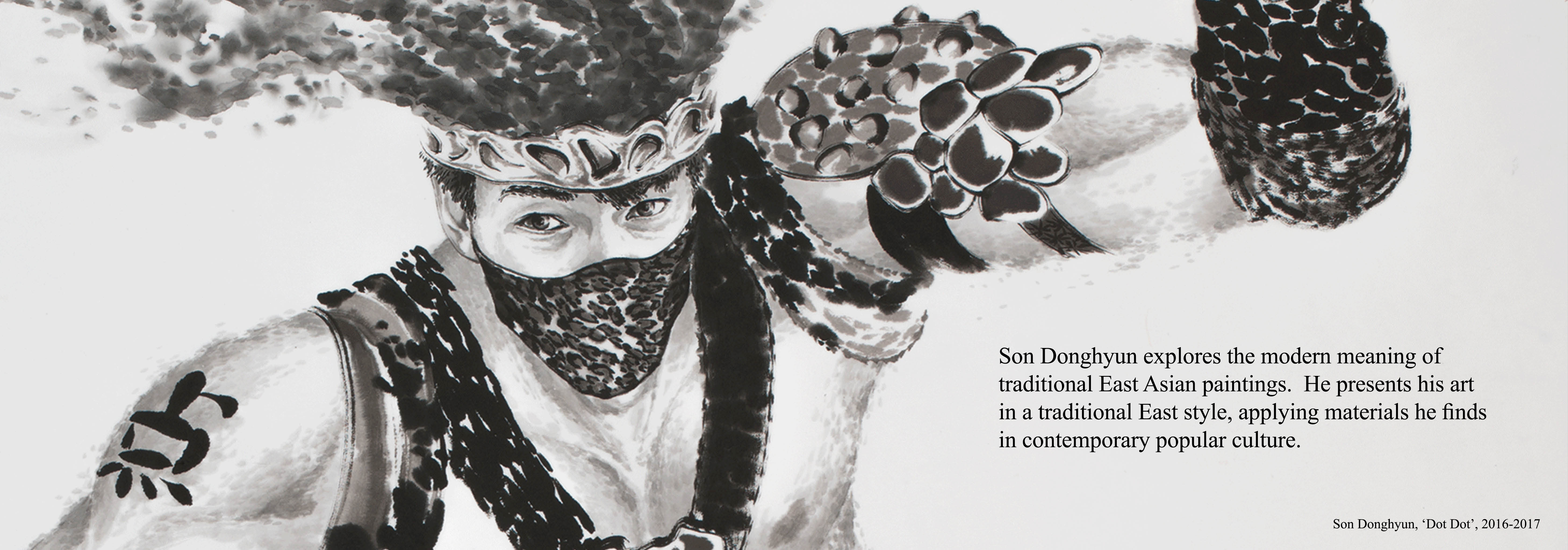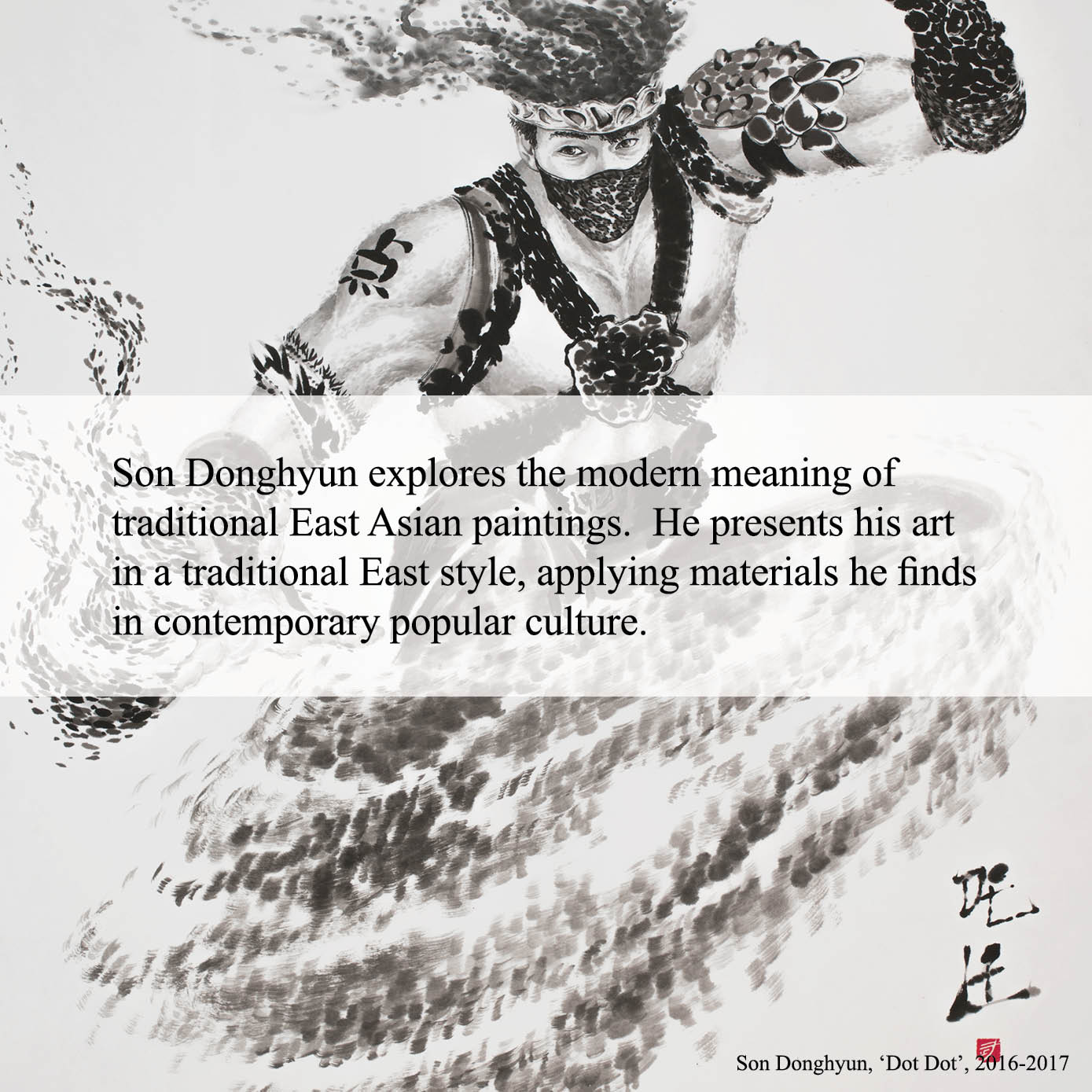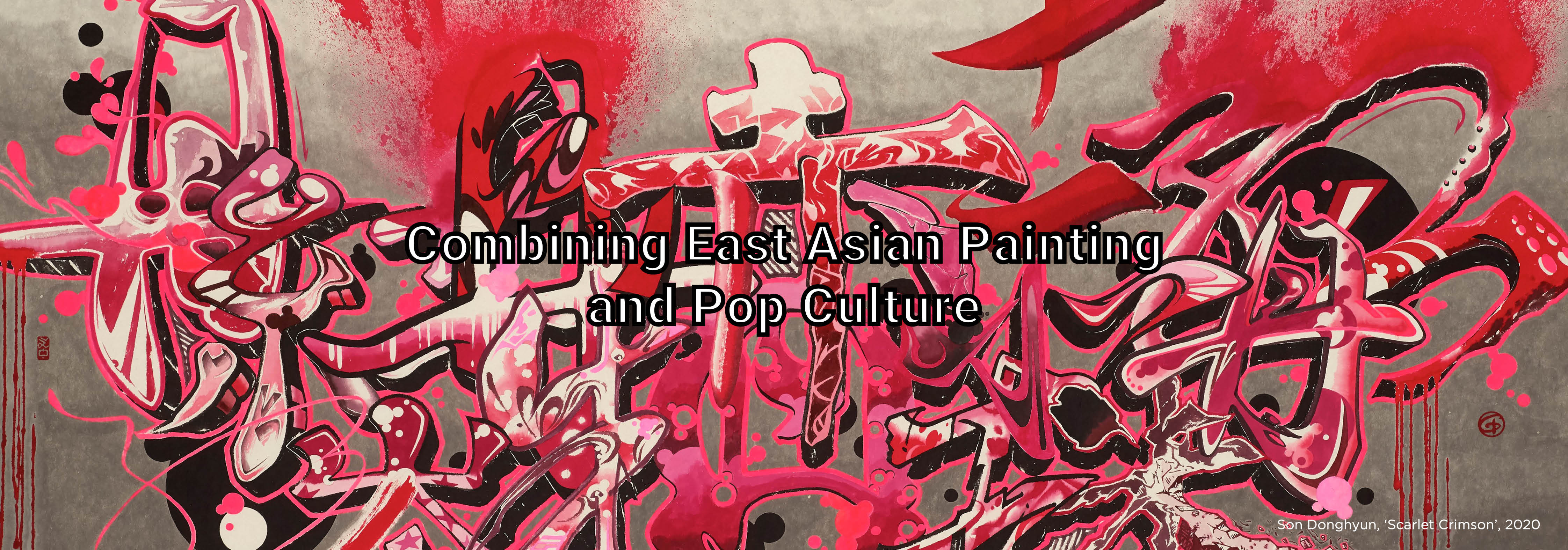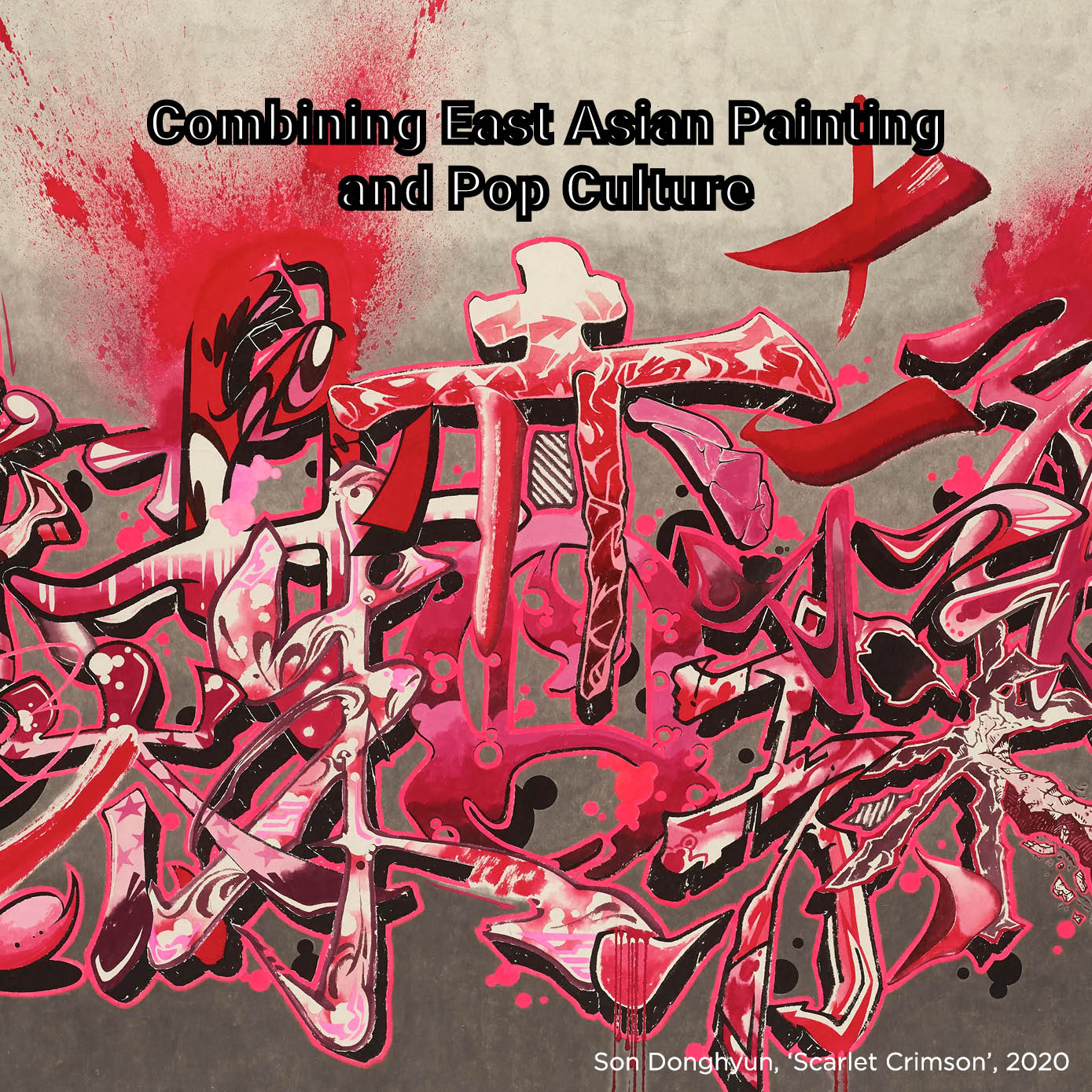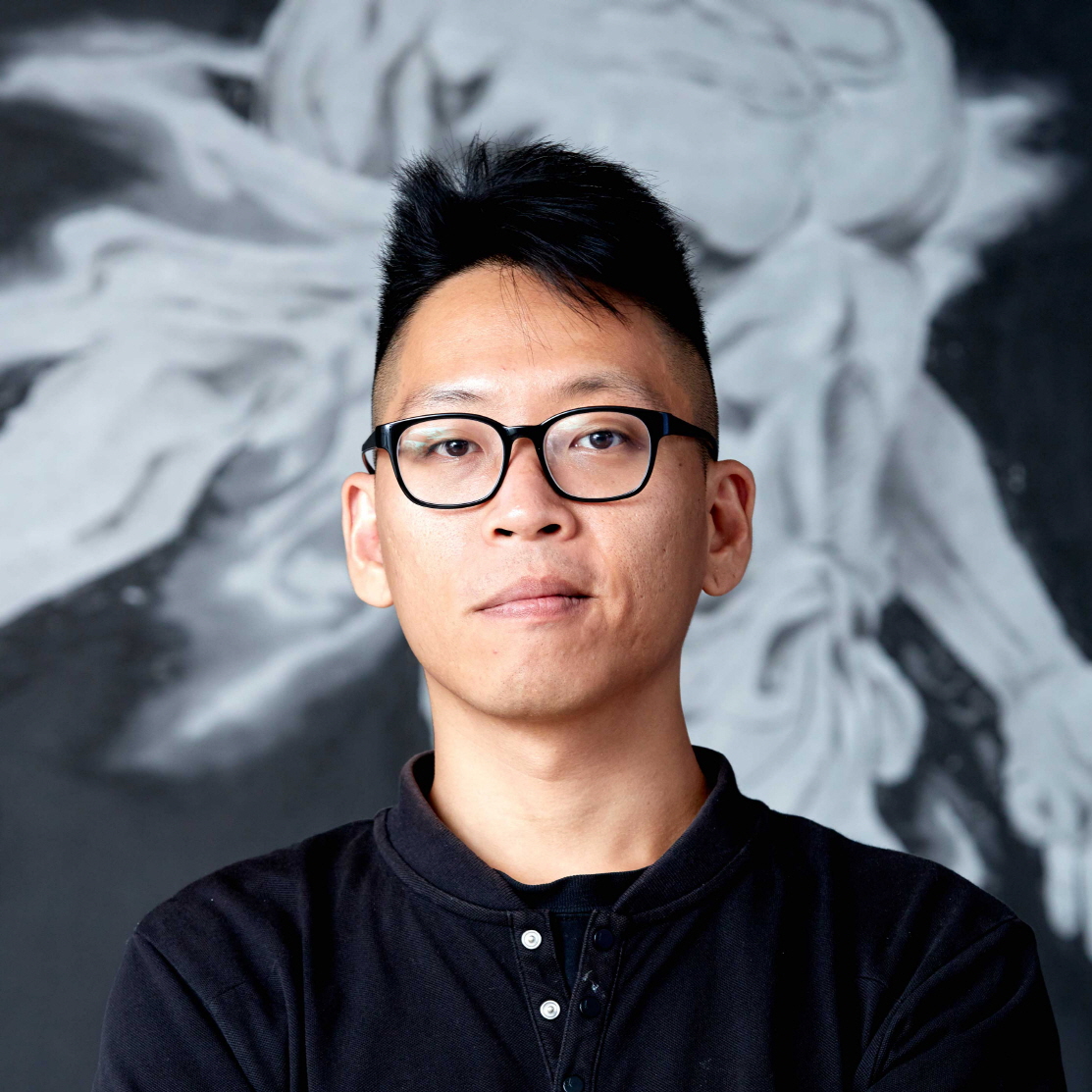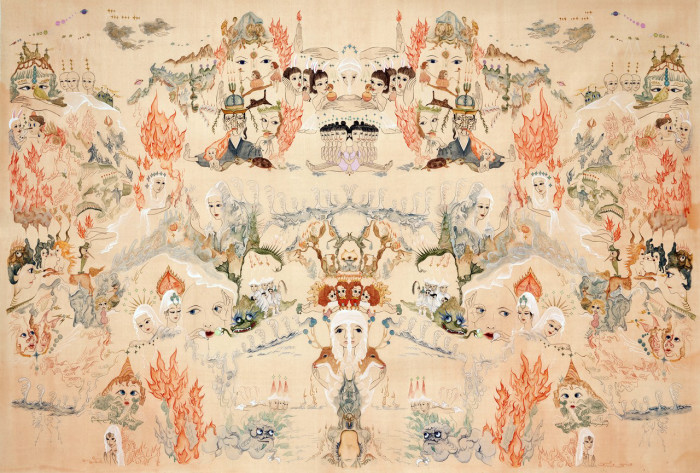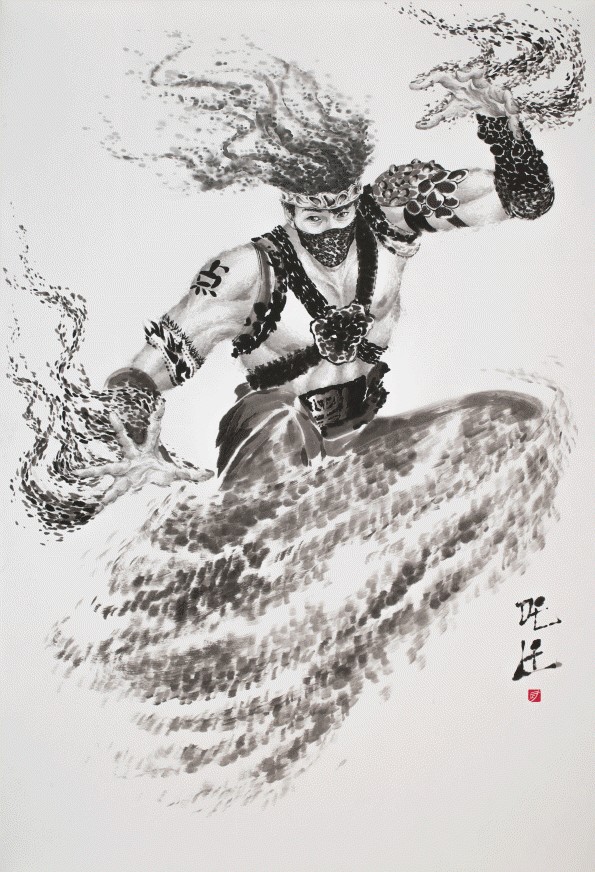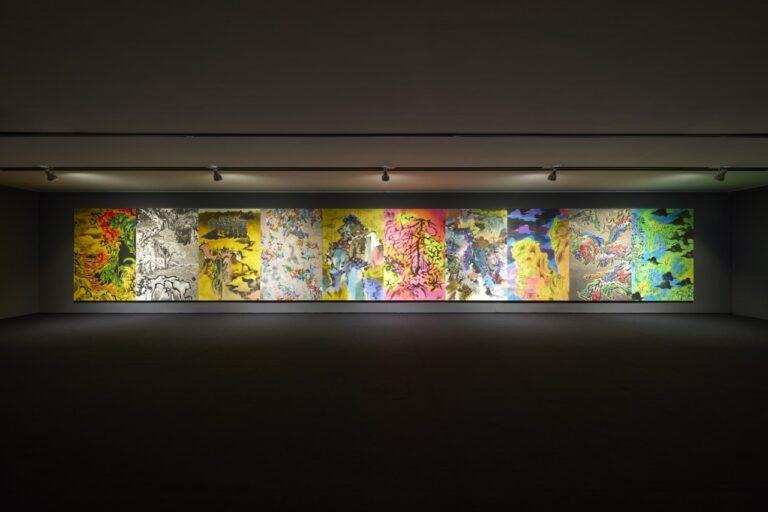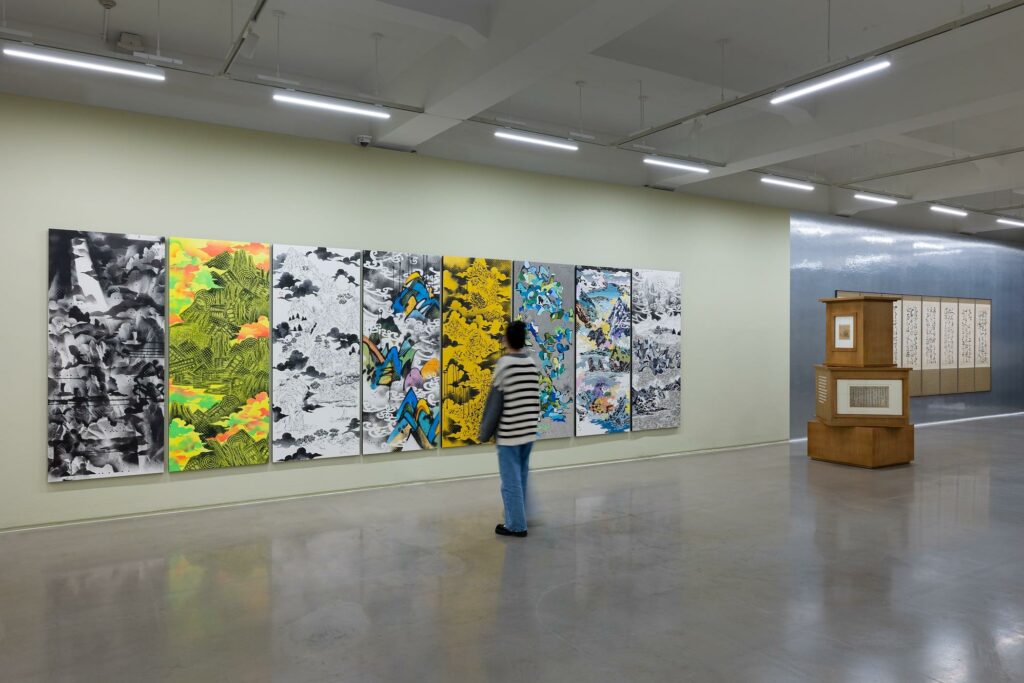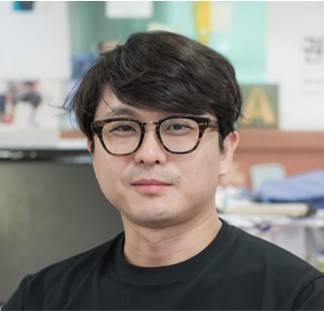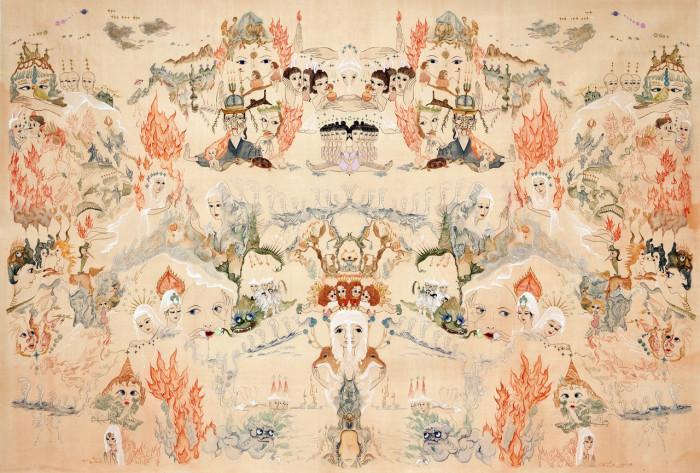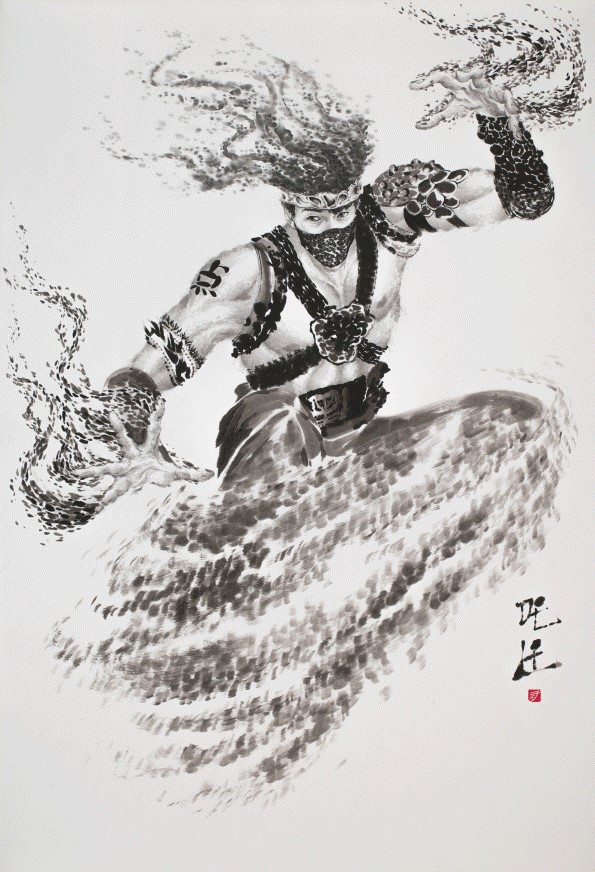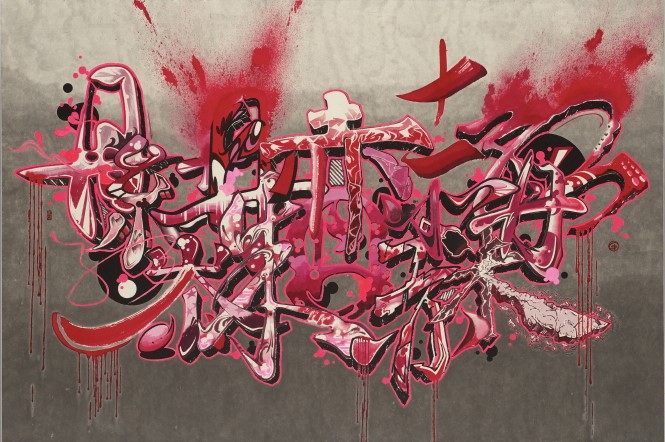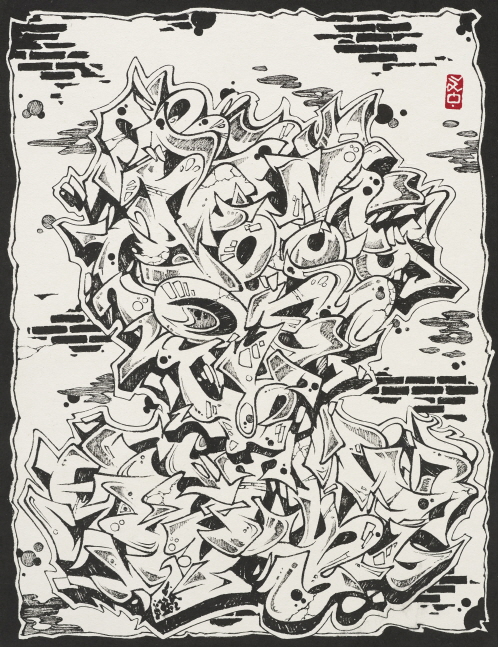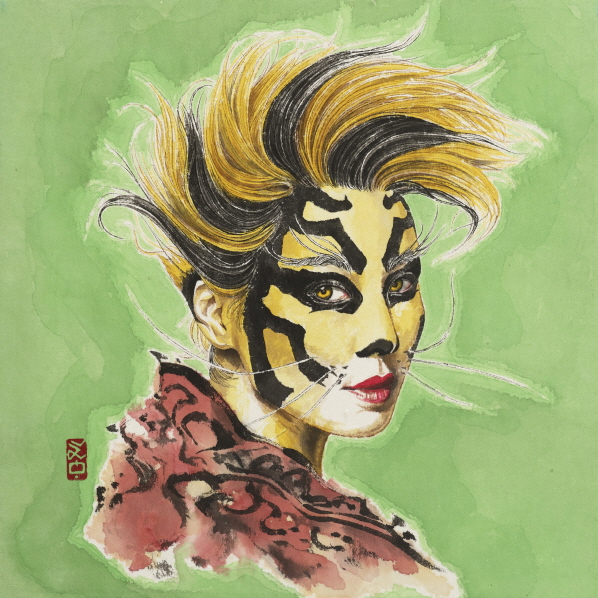Perhaps it was the
most natural flow of thought. I was thinking of his work all throughout
watching the movie Deadpool. In Deadpool, there is a protagonist whose
actions break the conventional stereotypes, constantly making jokes with
various references. The cartoon-like expressions that playfully interrupt
significant scenes were also reminiscent of his art. X-Men characters appeared on the screen as supporting roles, and
pop music of the 1970s and 80s made its way into the movie. As such, non-novel
cultures were mixed into the production of a new movie. Looking anew at
something with nothing new to it. This is a fitting description for Donghyun Son’s
art. Son creates new scenes by matching existing characters in the form of Korean
traditional painting, a form that is deemed old. And now I have been given the
chance to yet again elaborate.
There are many ways
to read the paintings of this still young artist that stood at the center of
attention upon university graduation and has since built a sturdy career
through repeated verifications. Such a great variety of narratives from diverse
perspectives are possible that it is difficult to select which one aspect to
focus on. He is a novel artist of Korean traditional painting
that has brought forth an original alternative amidst the crisis of Korean
painting. I could discuss a Korean style pop art (now that we even have a set
terminology of K-POP) in the genealogy of pop art. He brought portrait back to
the center of attention, a genre that has been rather marginalized in the
context of contemporary art. Most arresting for me as a writer is to discuss
him in terms of generation. Born in the 1980s and surviving the today, he is of
a generation that embraces a vast variety of symptoms and dons various names,
from the “0.88 million KRW generation” to the “N-forfeiting generation” that
faces even harsher conditions than the initial 3-forfeiting, 5-forfeiting,
7-forfeiting generations and has now given up countless things of life. The
generation represented by the artist, still in his 30s at the point of this
paper written in 2016, has had many ups and downs and has many stories to tell.
This generation was first-handedly introduced to various systems such as the
television, Internet, smartphone, and online social networking services. Thus
familiar with the new systems, the generation stood at the forefront of
building networks with the outside world based on the technology that was as
natural to them as their limbs. Son’s art is also appropriate for articulating
the effects of this surprising new culture. In fact, fully loaded with such
content, Son’s works themselves do not represent any technological advancement
by themselves. Rather, his works are closer to being an endeavor of pulling out
the forgotten tradition back into the present. However, the global reference
materials he appropriates would not have been possible without the help of the
Internet, and such methodology requires the generation’s sense as a global
citizen in regards to television, film, and music. It is thus sufficiently
worthwhile to discuss him in terms of the Internet generation. His art could
also be read as a satirical manifestation of a nationalism resisting against
cultural imperialism and the American hegemony. In a similar context, his art
is also a convenient example through which to explain the hybridity often
discussed in post-colonialism. There is ample value in diligently tracing and
summarizing in a textbook-like manner the process of change in the artist’s
oeuvre that has constantly developed over a period of more than ten years.
Looking back, a majority of critiques on his art have discussed him as a
generational symptom, and many have also interpreted his work as pop art and fusion
Korean traditional painting. Perhaps the most appropriate way to discuss his
art would be to talk of all this. I will thus seek to process his art through
various nets and filters, ultimately drawing a map.
Donghyun Son
entered Seoul National University as an Oriental painting major in 1998. In
2004, as an undergraduate, he started producing a unique grammar with his Portrait of the Hero, Mr. Batman, a
portrait of the American superhero Batman in Korean traditional painting
technique. In 2005, his second and third versions of Portrait of the Hero, Mr. Batman conveyed more elaborate and dense
descriptions. The 2005 was the monumental year he started to paint portraits in
full earnest. From the portrayal of Star
Wars characters in Portrait of the
Space Warrior, Mr. Yoda, Portrait of
the Droids, R2D2 and C3PO, and Portrait
of the Sith Lord, Mr. Darth Vader, to the portrayal of Shrek and Toy Story
characters in Portrait of the Dynamic
Duo, Shrek and Donkey, or Portrait of
Mr. Woody, and Portrait of Mr. Buzz
Lightyear, and also the portrayal of the McDonald’s mascot Ronald McDonald
in Portrait of Mr. Ronald Mcdonald –
all were painted within one year. And these pieces were brought together under
the title Pop-Icon:波狎芽益混 in 2006 for the first solo exhibition at Art Space Hue.
The history of portraits is very long, safe to say that it starts with the
birth of art. Ever since civilization and power were first introduced into the
history of man, portraits were produced as a means of documenting the powerful
and their families. From da Vinci to Rembrandt, Whistler, Repin, and Sargent,
there are many familiar and famous portrait painters. In this text, however, I
seek to locate the position of Son’s unique portraits in the context of contemporary
art. For Donghyun Son, born in 1980, Pablo Picasso (1881-1973) is just one
century apart in history. Let us start from Picasso, who developed his art
through various technical and formal experiments with numerous women as the
object of his portraits. Picasso’s portrait of Gertrude Stein in 1906 was
produced right before he surprised the world in 1907 with his Les Demoiselles d'Avignon. By
incorporating in painting the methodology of stiff description that seems as if
carved out of wood and inspired by African masks, it formally stays on the starting
point of Cubism and at the same time reveals the sturdy character of the
figure. Conveying the character of the portrait’s figure through exploration of
new form coincides with the nature of Son’s portraits. Son brings characters
from Western culture and fantasy, those unfit for the medium of Korean
traditional painting, into the form of portraits and also manifests the
spirituality of portraits as well. This is in fact the concept of jeonshinsajo (傳神寫照) that is greatly emphasized in East Asian traditional Art, first coined by
portrait painter Gu Kaizhi (顧愷之)[i]
of the Dongjin (東晋)(317-419) dynasty
to convey the task of reaching beyond a mere representation of form and seeking
to paint even the mind. Gu argued that the specific background of each portrait
should be employed in conveying the object’s mind, and Son uses each
character’s representative props or costume, or even the transformation process
of the character’s appearance itself to portray the character’s personality.
Translating into Korean traditional paintings the portraits of characters who
have already succeeded in manifesting their virtual characters in films and
expressing their identities not only through their own bodies but also related
props, Son could very effectively manifest the jeonshinsajo. In fact, most portraits in modern art cannot but be jeonshinsajo not so much because of
their realistic portrayals, but because they focus on expressing the figure’s
sentiments. Alice Neel (1900-1984) founded her practice upon intimate
relationships with her objects and also sought portraits that convey even the
inner hearts of the figures. Come to think of it, who could be better at
conveying the inner image of the object than Lucian Freud (1922-2011)? Setting
aside the fact that his grandfather was the grand psychologist Sigmund Freud,
the painter’s endeavor to portray the human’s sentiments and character through
the expression of body and skin is clearly evident on the canvas. Somewhat
coeval American painters Larry Rivers (1923-2002) and Alex Katz (1927-) also
come to mind. Their styles are very different, but they can be aligned in the
context of Western jeonshinsajo in
that they painted numerous portraits of their friends and thus revealed their
own relationships with the objects in the paintings.
And then Andy Warhol (1928-1978) suddenly pops out. Our young art student
in Korea inherited from this Pop Art founder the methodology of borrowing the
fame of superstars. Leaning on the portraits of the most famous people of the
times such as Marilyn Monroe, Jacqueline Kennedy, Elvis Presley, or Elizabeth
Taylor, Warhol became as famous as any one of them. On top of that, the beloved
Campbell Soup and Coca-Cola are also popular items that Warhol is indebted to.
Son’s methodology of appointing familiar models such as Michael Jackson, Shrek,
and Superman, or of bringing Coca-Cola and Nike logos into paintings all stem
from Warhol. The Logotype series that
the artist concentrated on in 2006 puts at its forefront the familiar logos of
various brands that were borne not out of cultural purposes, but as commercial
means. These pieces that accentuate the global brands of Adidas, Starbucks,
Coca-Cola, Nike, McDonald’s, and Marlboro are very amusing to observe in
detail. Logotype-Coca-Cola is a
canvas filled with the Coca-Cola logo in a cursive font. Inside the logo is an
array of elaborate and witty images that don the disguise of pattern. Referring
to the fact that Santa Claus is a character fabricated for the advertisement of
Coca-Cola, he painted a scene of Santa Claus delivering presents while carrying
a Coca-Cola, and also borrowed the famous image of a polar bear drinking Coca-Cola.
Logotype-Marlboro also portrays the
stereotyped image of the Marlboro Man and the image of characters dressed in
Chinese traditional clothes and hairstyles while smoking and wearing Western
boots and Cowboy hats. Logotype-Nike
and Logotype-Adidas are also adorned
with patterns of people wearing Nike or Adidas, and related sportsmen images.
Slogans that each brand advertises, such as “Just Do It” and “Impossible is
Nothing”, are also decorated as patterns while each alphabet is placed inside a
round badge. By actively bringing popular consumer items into the frame of Korean painting, Son also breaks down the
boundary between image and text. As with calligraphy where the letters
themselves become the artwork, or the literati paintings where text and image
coexist inside one screen, which were favored by the gentry who had regarded
the talents of producing poetry and painting as refinement, the tradition of East
Asian traditional Art does not clearly
distinguish image and text. Son’s Logotype
series combines the forms of calligraphy and genre painting, and further mixes
Western brands and mass media in its contents, flaunting the painter’s unique
sense of editing. In the West, pop artist Robert Indiana (1928-), a coeval of
Andy Warhol, had also embraced text as image. The portraits produced by Mel
Ramos (1935-) and Tom Wesselmann (1931-2004), a mix of advertisement and
pornography, were also attempts by Warhol’s coevals to appropriate both
capitalism and Warhol at the same time. As such, it is effortlessly enjoyable
to transcend all temporal boundaries in reading the cultural and social
references of both the East and the West through the productions of this young
man that majored in Oriental painting in Korea.
There were also artists using photography in producing the portraits of
their generation. Cindy Sherman (1954-) and Nan Goldin (1953-) are such
examples. Sherman’s photos in which the artist played various roles to reveal
the cultural stereotypes of the generation, and Goldin’s photos that capture
the everyday of her friends from a very close distance. Only the medium has
changed, while still serving the traditional role of portraits. Nikki S. Lee
(1970-) would be their descendent, penetrating the stereotypes of each
nationality and capturing natural portraits. Stereotyping is in fact the
imperialist tactic for seizing cultural and political hegemony. As Edward Said
had pointed out, they produce a stereotype that the Oriental, the East, is
sentimental, mystic, and feminine to contrast the opposing Western society as
rational and masculine. They designate “the other”, and start stereotyping and
otherizing as a means of rationalizing their operation of empires. Therefore,
the very basic in discussing post-colonialism is to break free of that
standardized thinking. For this incredibly talented painter born in a small
country of the Far East, a country that also bears the history of colonization,
to extract the innate traits of foreign super heroes, pop stars, or cartoon
characters and paint as closest as possible to the original image is to push
the standardized ideas to their extreme. Here, it is worthwhile to study why it
is meaningful to translate the standardized ideas of cartoons and films into
painting. I should mention here the point where the two stereotypes produced by
imperialists collide one another. And the crash that occurs at that point where
the product of cultural imperialists, the Hollywood characters or the grand
heroes unlikely to exist in reality, are reproduced into the unique culture (Korean
traditional painting) of “the other” that is regarded as feminine and savage.
Under colonial rule, the ruler orders that the colonized should “follow the
lead of the ruler, but only to be similar, and never should be completely
same”. The colonized is ordered to conform to the ruler and become similar, but
only to the point of being different enough to be distinguished from the ruler.
This hybridity, a tactic through which to signify that the colonized shall always
remain as the crossbreed, is a bit specially interpreted in Son’s works. For
instance, as Homi K. Bhabha had argued, it creates not the distinction between
the self and the other or between one’s own culture and the other’s culture,
but produces the “borderline” or the “in-between” space. To speak from the
point of post-colonialism, it transcends the dichotomous distinction between
the ruler and the colonized, and designates a third space. This does not mean
to awkwardly follow the major, but to stand in between the major and the minor
to be able to refer to each aspect and yet create something completely new. It
is under this same context that Son’s art mixes various classes and cultural
devices to penetrate the in-between space.
In the meanwhile,
the works of Jim Shaw (1952-) and Mike Kelly (1954-2012) bear resemblance to
those of Son in a way different from that of portrait painters. These two
artists, born around 1950, presented works in which they added their personal
tastes onto various American cultures encompassing comic books, album covers,
magazines, religion, post-punk politics, and black humor. Their productions don
various forms from installation to painting and video, and while they are
diligent compositions of cultural references and may seem similar to secondary
productions, judging from the point of contemporary art grammar, they merely
take on the methodology of simple appropriation. Son’s work is just like this.
Because he brings in the images of characters and famous people that he has perfectly
interpreted through his own style, no one can mention secondary production or
plagiarism. The only difference between Shaw or Kelly and Son is that while the
former appropriate their domestic contents, Son employs foreign contents that
have been imported into his domain.
Palimpsest is a
term stemming from the ancient way of writing when there was no paper and
people made new books by erasing the preexisting letters and rewriting on
parchment. In that the cultural identity of colonies cannot start from a white
slate and is only rewritten from the state of being stained with various
products of imperialism, the historical documentation of colonies is likened to
palimpsest. Now it also signifies the comprehensive contents of multi-layered
meanings. When Son becomes an active subject and not a hybrid in embracing the
Western elements, -- that is, when he paints characters of Western culture on Korean
Mulberry paper -- there is already an
accumulation of such a variety of layers, from the paper to the character, that
it cannot be simply regarded as mere “painting on paper”. Among the
post-colonial resistance discourses is the “Writing Back” tactic through which
the colonized becomes the subject and rewrites English literature classics.
Nancy Rawles’ novel My Jim was a
rewritten version of Mark Twain’s Adventures
of Huckleberry Finn from the perspective of a black woman with Africa as
the background. If I were to discuss Son’s methodology within the context of
post-colonial theory, I would say that it is closest to this “Writing Back”.
But it is not a perfect match in that while the speaker, technique, and
background are autonomous, the protagonists of the canvases are still the
products of imperialism. As mentioned before, however, Son’s work is attractive
because it does not perfectly conform to any given frame. He has succeeded in
creating an exquisite in-between space that does not belong anywhere and yet
seems to fashionably fit anywhere.
After the advent of the aforementioned group of photographers, we saw a new
group of portrait painters of yet another form. John Currin (1962-) humorously
conveys glamorous blond women through exaggeration and distorted editing as the
likes of cartoons to expose the vulgar taste of white men. As a device through
which to ridicule the masculine perspective from the perspective of women, Lisa
Yuskavage (1962-) employs a portrait of women that is exaggerated and distorted
to the opposite sense of Currin’s, but also embraces very cartoon-like senses.
In fact, Korean traditional painting shares more common grounds in terms of
material with cartoons that are expressed through pencil, pen, and water paint
on paper than with oil painting on canvas. The attempt and eventual success of
hauling the vulgar or B-class culture (as cartoon and third-rate magazines are
deemed as a group) into high culture were shared among this group of portrait
painters. In a way different from that of Warhol’s, there is a way the icons of
pop culture and B-class culture that Son appropriates correspond with this
group of artists’ models. Although I hesitate to repeat, because the characters
that Son puts forth as his models are in many cases the products of cultural
imperialism albeit being classified as B-class, Son’s art produces various
complicated contexts for other nations who also import that culture.
From 2005 to 2007, Son painted two to three animal portraits each year. I
say animal portraits, but they are in fact all animal characters from
animations. Designating the Bugs Bunny and Sylvester from the 2D animation Looney Tunes as the models, Rabbit and Rabbit and Sparrow were produced in 2005. In 2006, he painted Road
Runner and Wile E. Coyote in Bird and Dog
under Bamboo, and Daffy Duck and its baby in Birds. In 2007, the tiger model Tony for the cornflakes brand
Kellogg’s was portrayed in Tiger under
Pine tree, and two Toucan Sams from Froot Loops were painted in Two Magpies. One significant trait of
this group of canvases portraying the animal characters is that each of their
characteristic background is also introduced in the screen. Tony stands robust
under a pine tree wearing a red scarf, while Toucan Sam sits on a tree along
the ridge. Wile E. Coyote hides behind a rock, and Sylvester wickedly waits for
Tweety to fall from the branch into his hands. When we say that it is possible
to classify culture as high and low, the animations that children enjoy are deemed
bereft of depth in contents and regarded as the low culture. Son’s methodology
is to mix this low culture with the literati painting of the East’s high
culture that was greatly appreciated by the gentry. If we take one step further,
Korean traditional painting, now an object of no interest regardless of class,
will be classified as the non-major while the cartoons, still greatly loved by
many, is deemed the major. We cannot avoid the discomfort and awkwardness that
arise when transcending the different layers of countries, times, cultures, and
classes. It also points out the reality in which the cultures are ranked not by
the evaluation of each culture’s value itself, but accordingly to the hegemony
of the times. This interesting conflict between culture and class is, if I were
to make a figure of speech, like Disney’s Mickey Mouse appearing on Im
Kwon-taek’s[ii] film. To use this metaphor in reverse, it is as if
Dooly the Little Dinosaur[iii] or Run Hani[iv] were portrayed in traditional Western portraits
painted in the grand manner of Ingre and David.
Frantz Fanon, who
had stood at the forefront of the third world’s anti-imperialist movements and
led the independence of Algeria, said “I resolved, since it was impossible for
me to get away from an inborn complex, to assert myself as a black man. Since the
other hesitated to recognize me, there remained only one solution: to make myself
known.” And a new trend of black portraits stemming from such thoughts was
brought to attention. Lynette Yiadom-Boakye (1977-) creates characters in
literature that have black people as the protagonist and paints their
portraits. Kehinde Wiley (1977-) puts common black people inside the
composition of portraits of heroes, such as that of Napoleon, and questions the
function of portraits. As such, Yiadom-Boakye and Wiley put their
minority-ness, or to borrow Fanon’s expression, their “complex”, at the
forefront and attempt to reach beyond merely “coveting the mainstream” and
instead “overcome the mainstream”. Then what is it that Son seeks to achieve in
painting the portraits of American mainstream characters? Is it to “explicitly
look up to the mainstream”, to humorously flaunt cultural sycophancy? Furthermore,
he portrays the mainstream through Korean traditional painting techniques, the
perfectly non-mainstream in the contemporary art scene. This is not all. We can
also see that he puts quite some interest and focus on the villains and
supporting roles as well. Apparently not insisting only on the mainstream, even
the superhero films and animations he refers to are in fact closer to the
subculture with mania fans. Thus, although the methodology and final products
are different, Son’s tactics are similar to those of Yiadom-Boakye and Wiley in
that they subtly mix the mainstream and the non-mainstream. Son has said that
he is more interested in history than in specific phenomena. “When introducing
an image, it is to reveal the history.” Then why is the history that the artist
mentions portrayed and conveyed through the image of heroes created by
foreigners, founded upon foreign films and animation characters, and in
particular the American cultural imperialism? The question also remains as to
why it has to be American culture. This could be a reflection of the artist’s
personal taste favoring hip hop and American culture, and this is also a
reflection of the reality that Korean culture is consistently and greatly
exposed to American culture. For an individual who grew up in Korea after 1980
to speak of his relations with the media, it is difficult to not mention
Hollywood movies or their expansions, the animations of DreamWorks or Pixar and
Marvel Comics. We need to understand the peculiar cultural colonization that
requires us to speak of American culture in order to discuss Korean culture.
This is also why it is necessary to tediously and continuously explain the
works in relation to postcolonial discourse.
At his solo
exhibition King in 2008 at Gallery 2,
Son pertinaciously tracks the transformation process of Michael Jackson’s
appearance since his debut. Painted in the form of traditional portraits of
Kings, there were about 40 Michael Jacksons sitting on the traditional Korean
throne. Like Portrait of the King (01 got
to be there), Portrait of the King
(22 man in the mirror), and Portrait
of the King (33 scream), each piece in the series was numbered and labeled
the title of the album that Jackson released around the time he looked like how
he is portrayed in the portrait. The young Michael Jackson was first seated on a
leopard printed chair, and it was from the 1989 when he earned the name “King
of Pop” that he sits on the red throne. From Portrait of the King (26 black or white) to the final Portrait of the King (40 one more chance),
he was never robbed of his throne. The process of the King of Pop’s struggle to
erase his identity as a black man through plastic surgery is clearly conveyed
throughout the 40 chronological portraits. Bhabha had said that under
colonization, mimicry comprises the potential of resistance and overthrow. By
mimicking the ruler, the colonized threatens the authority of the ruler, making
the ruler anxious about the possibility that those mimicking them could
eventually throw a riot. Bhabha had thought that such mimicry and its symbolic
resistance could damage the solidity of imperialism. However, it is worth
looking into what Son has tried to say by tracing this eccentric trajectory of
mimicry by a man who, as someone from the non-mainstream, ascended to the top
of the mainstream and sought to shed of his original identity. It seems that
Son tried to convey the jeonshinsajo
in its true essence, observing the changing faces of a man as he shifts from
the colonized (black man – child – rookie singer) to the ruler (white man –
adult – King of Pop). No other man has ever manifested the process of migration
from the non-mainstream into the mainstream as bluntly as Michael Jackson. And
no other man has willfully changed as successfully as Michael Jackson. Of
course, there would be various judgments on the usage of the term “success”
here. Because Jackson was never away from public attention or popularity, it
would have been easy for Son to acquire the materials of any period he was
interested in. One man’s changing appearance and newly released albums served
as the archive of an era. Tracing the history of the man, we can also follow
the trend of culture through the costumes and appearances donned by the King of
Pop that led the fashion.
In his 2010 solo
exhibition Island at Project Space
SARUBIA, Son introduced his folding screens to the public. Referring to the
list of “10 Best Movie Destructions of New York” selected by the New York
Magazine, he referenced the city smashing scenes of Deep Impact, Armageddon,
and Godzilla, reinterpreting them
from various perspectives and painting them in the form of folding screens – an
eight fold folding screen, composed of eight scenes. Unlike his previous works,
he worked in the form of ink painting bereft of color, and with the intention
to paint landscapes, focused on portraying scenery rather than people.
Encompassing all genres of East Asian traditional Art from
portrait and landscape to literati paintings of the gentry and calligraphy, the
artist portrays the material he is most interested in with the medium he is
most comfortable with. At the same time, he is weaving a tight archive of
cultural and art historical narratives, placing himself in a very unique
position with art history. It seems Son’s art itself serves as the hybrid
mutant in this complicated world. While hybridity may embrace a negative nuance
within postcolonial discourses, this hybridity is in fact the character of
Son’s art. If one were to become a mutt, one should stand at the center as the
“super mutt” like the superheroes he paints, and thus be able to counterattack
the ruling power. In fact, mutts have started fighting back a long time ago.
K-POP has reproduced American pop music in Korean style and earned great
popularity within Asia, recently extending its fame throughout America and
Europe too. On a slightly different note, there are also Hollywood movies that explicitly
play the hybridity card, as in the case of Kung
Fu Panda – contents of hybridity that a major Hollywood company produced by
mixing various elements of numerous nations in order to target the entire
world. In a globalized world, there is no limit to transcending boundaries. The
boundary between what is yours and what is mine becomes ambiguous, and clear
perspectives that help discern and characterize within that ambiguity become
precious. This is the point Son’s Korean traditional paintings of Western
contents become valuable.
In his Villain exhibition at Gallery
2 in 2011, Son traces the change in villains throughout the 20 episodes of the 007 series between 1962 and 2002. In
this series of panorama, he categorizes the object of fear that is
characteristic of each period. During the Cold War, a man of Socialist uniform was
the object of fear and the role of signifying the evil went to billionaires or conglomerates
after the success of capitalism. The typicality of the one-eyed villain boss giving
out brutal orders while affectionately petting their pets such as cats or
chameleons was also repeated. The image of evil associated with the North
Korean military or black men dealing drugs is continued to this day. Louis
Althusser has explained the concept of “interpolation”. Each individual that
has been called forth under the ideology of imperialism has to follow the
ideology of imperialism. Here the term imperialism refers to a temporary system
of values that is created to seize the hegemony of a certain group in a certain
period. Althusser speaks of the mechanism of power operated through stereotying
and otherizing, and the ideology of interpolation. For instance, communism is
deemed evil in a society where communism is designated as the other, and each
individual regards communism as evil not through their own judgment but the
hegemony set by imperialism. As such, the source of evil is very political. Villains
are in fact titled as villains not because they have done evil deeds, but as
the product of distinguishing and otherizing.
In 2011, the same year the Villain
exhibition was held, Son also produced the Mask
series of 41 episodes. It was a composition of masks that appear on various
hero narratives. In 2012, he produced around 50 goods, painting various space
shuttles on fans. The From Outer Space
series, collecting 22 outer space characters in one old book, was also produced
in this year. The Robot, a collection
of 22 robots in one old book, was also painted. The artist’s experimentation
outside the conventional form of frame mounting was very active this year. While
bringing change to the appearance of his works through the form of fan and album,
he also obsessed more over goods than on characters, more strongly expressing
his mania for collecting materials. It was the phase of delving deep into one field,
as if an otaku, and producing paintings as the product. In fact, all of Son’s
works are greatly associated with the otaku-like collection of material. In
other words, it could also be described as similar to the attitude of a scholar
collecting material for dissertation. But because his interests lie in maniac
animations and films that the otaku also find interesting, it is better fitting
to call him an otaku. Please forgive my rather radical categorization.
The art of a famous artist that has gained a stable status of fame goes
through a drastic change in 2014. Seemingly completely “post”colonial now, the
artist started creating his own characters. Even the title of the exhibition
held at Willing N Dealing in 2014 was Pine
Tree, hinting at independence. The pine tree that had traditionally
portrayed the dignity of king in “Sun and Moon and Five Peaks”, the fidelity
and integrity of the gentry in “Wintry Days”, chased away the evil with its sacredness
in “Magpie and Tiger”, and signified longevity in “Ten Longevity Symbols”[v],
was reproduced as a mighty superhero by Son. Having cultivated his talent of
creating and mixing to its peak, the artist was partially inspired by the
characteristics of existing superheroes when creating four unique characters: Pine the Great,
Mister High Fidelity, Shaman the Evergreen, Master Knotty Needles. Just as
Cindy Sherman had borrowed the stereotypes of classic films and shot the image
of herself in her early works, and thus earning suspicions of recreating an
existing scene but in fact having created an entirely new scene, Son produced
purely new heroes that seem familiar. In Pine
the Great, the spikey straight lines of the green pines transform into
hair, while the hard skin of the pine tree is already in the pattern of armor.
The curves introduced in Mister High
Fidelity and Shaman the Evergreen
signify the beauty of pine trees that have endured through the harsh winds and
times. Master Knotty Needles portrays
the acute image of a hero, founded upon the sharp leaves of the conifers. Scrolls
created as posters and the front pages of comic books were also on display,
capturing not only these characters but also their opposing villains. The names
of these pine tree characters were written in completely new letters, based on
the Chinese contemporary artist Xu Bing’s creation of Chinese character forms
produced with Roman alphabets. This new form of mixing -- appropriating the
methodologies of contemporary artists such as Sherman and Xu Bing, and creating
his own characters -- is the recent trend of Son’s art. And here, I am yet
again drawn to where Son appropriated Xu Bing’s letters. The image of these alphabets
disguised in the form of Chinese characters implies that the world’s mainstream
letters would have looked very different if China had won the hegemony of world
history. Xu Bing’s philosophy, borrowed from Mao Zedong, to “make the old
things serve the present, make foreign things serve China” seems to represent
Son’s attitude toward art.
When it seemed
there would not be any new changes, this diligent worker that does not stop
updating himself showed yet another evolution at SongEun ArtSpace in 2015. He
produced a portrait series under the name Six
Warriors (六俠), based on “Xie He’s
six principles of Chinese traditional painting” that the painter of the
Southern Qi dynasty (479-502) had presented as the six essentials of landscapes.
Having created new characters based on this representative discourse of East
Asian traditional Art, the series is similar with the Pine Tree exhibition in that it introduces characters created by
the artist. Within this series composed of six warriors, the artist
reinterprets the six principles of painting as the characteristics of martial
specialties possessed by each warrior. For instance, Son painted Master Spirit through a composition of
various energy expressions conventionally used in animations in order to convey
the “spirit resonance”, one of the six principles of painting.
The reference
materials available to Son are Google-like. Ten years ago, I would have
described his global and trans-temporal appropriation of knowledge as
encyclopedic, but times have changed. No one buys the encyclopedias or Oxford
dictionaries abandoned in the secondhand bookshops. We live in an era where we
type in the keyword, click enter, and is provided with endless information
within a second. In this Googling era, Son shows us the smart editing
technique, or in more trendy terms, the art of curating. Son’s painting is a
fusion bibimbap (mixed rice) that has
invested time in thoroughly studying the traditional recipe, kept the good
parts and gotten rid of the unnecessary. A great dish of bibimbap with nicely cooked rice with colorful and pretty toppings
that was even mixed well into harmony. Now, we have the extraordinary bibimbap. And the baton has been passed
on. Now we have the issue of how we will position this menu as a popular item
in the global village, as popular as rice noodles and burritos. Bibimbap was able to enjoy a
semi-success in New York because New Yorkers had misunderstood the dish. Crazy
about eating green, they had deemed bibimbap
as a sort of salad and opened their hearts to it. They saw it as a Korean salad
with an extra touch of rice, and regarded it as a familiar and healthy dish. It
is not difficult to witness New Yorkers with the dish, mixing the rice and
vegetables with fork and chopsticks. Then, what if we were to accentuate the
mysterious Korean or East Asian traditional Art concepts less, as they are
difficult to explain in detail, and instead promote Son’s art as a Korean
contemporary painting of a different style that resembles comic books? I merely
wish that more people and more venues would be exposed to the great fun of
reading the little details of his paintings. The truth is, there is no need to
draw any metaphor or conclusion on Son’s art. His art has always changed, is still
changing, and will keep on changing and evolving. There will emerge new
cultural references as numerous as the stars in the sky, and he will fabulously
edit the chaotic contents and allow us to look back at the present. And his
ceaseless transformations and editings will not let us down. I am impatiently
curious for his future. I cannot wait to see his works of ten years from now,
and the unknown of twenty years from now is even mystical. It is without a
doubt a great fortune that I can live his contemporary and wait for his next
works.
[i] Gu Kaizhi was a celebrated painter of ancient China. Also a talented poet and calligrapher, he wrote three books about painting theory: On Painting (畫論), Introduction of Famous Paintings of Wei and Jin Dynasties (魏晉勝流畫贊) and Painting Yuntai Mountain (畫雲台山記). He wrote: "In figure paintings the clothes and the appearances were not very important. The eyes were the spirit and the decisive factor." (excerpt from Wikipedia)
[ii] Im Kwon-taek (born May 2, 1936) is one of South Korea's most renowned film directors. In an active and prolific career, his films have won many domestic and international film festival awards as well as considerable box-office success, and helped bring international attention to the Korean film industry. (excerpt from Wikipedia)
[iii] Dooly the Little Dinosaur is a 1983 South Korean cartoon and animated film created by Soo Jung Kim. Dooly is one of the most respected and commercially successful characters of South Korean animation. Dooly became the first cartoon character to be featured on a stamp. It was printed in 1995 in South Korea. Dooly has a resident registration card, which means he is a citizen of South Korea. (excerpt from Wikipedia)
[iv] Run Hani is the first South Korean series animation that portrays the adolescent life of a girl who lost her mother at a young age and grows into an athlete. Authored by Jinjoo Lee, it was featured in a cartoon magazine from 1985 to 1987, and was produced into an animated film in 1988.
[v] As an all-time favorite subject of the gentry in Korean traditional art, the pine tree was traditionally used to portray various virtues in four typical forms of painting and under the following titles: “Sun and Moon and Five Peaks”, “Wintry Days”, “Magpie and Tiger”, and “Ten Longevity Symbols”.



